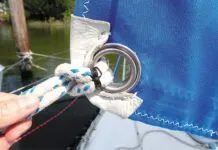We recently had a letter from Teun and Chantal Bos, who were trying to determine what diameter anchor snubber to use. Practical Sailor did extensive testing in this area, but unfortunately some of the formulas used to determine the right size snubber—strong and chafe resistant yet elastic enough to absorb shock loads —were lost in translation as we migrated to the new website.
As a result, the equation online yielded some clearly absurd results. In the case of the Bos’s, it recommended a 12-inch diameter snubber for their 49-foot Oyster pilothouse, Beryl, clearly out of wack with reality.
As a result, we reviewed and updated the equation and the table in our original report, “What is the Ideal Snubber Size” The updated equation below should bring you within the ballpark for your boat.
Diameter (inches) = 0.00067 x (length overall in feet) x (loaded weight in pounds)^0.3
Keep in mind, this is a rough guide for estimating the length and diameter of a snubber based on projected loads. It applies exclusively to 3-strand premium nylon from a reputable ISO-certified rope manufacturer (Yale, Samson, and New England Ropes, Novabraid, etc.). The ideal snubber dimension can vary greatly from boat to boat, and conditions. The aim is to have rope that offers plenty of stretch, and a breaking strength with an ample safety margin under projected maximum loads. When in doubt, round up to the next larger size that what the formula recommends. For moorings or use in consistently windy conditions, go up one size from the formula recommendation.
In general, the snubber will be one size smaller than the boat manufacturer’s recommended nylon anchor rode. For more on rode loads, see “Anchor Testing and Rode Loads,” and “The Load on Your Rode.”
You will need to make a judgment call regarding whether your boat is light, medium, or heavy, bearing in mind that a boat with high windage or that yaws excessively at anchor, will have higher rode tension. In which case, you might have to take other measures to reduce yaw.
In truth, there are a range of right answers. Stronger lines last longer but absorb less shock. Lighter lines will need to be retired sooner but will put less stress on the anchor and rode. As long as you stay in the range, you should be fine. The biggest error we see in snubbers are that they are too short, not protected against chafe, or equipped with poorly engineered snubber hooks.
To really get to the bottom of anchors, rode, snubbers, and the specialized gear and techniques for ensuring your boat stays put, our four-volume series on anchoring “Anchoring the Complete Series,” presents more than two decades of research.
SNUBBER SIZING EXAMPLES
| BOAT MAKE & TYPE | BOAT LENGTH | DISPLACEMENT | SINGLE SNUBBER DIAMETER (estimated 3-strand premium nylon) | BRIDLE DIAMETER (estimated 3-strand premium nylon) | SNUBBER LENGTH (estimated 3-strand premium nylon) | Type (actual rode in use) | LENGTH (actual rode in use) | DIAMETER (actual rode in use) |
|---|---|---|---|---|---|---|---|---|
| MONOHULLS | ||||||||
| PACIFIC SEACRAFT 34 | 34 Feet | 13,500 lbs. | 3/8” /9mm | not applicable | 44 feet | 3-strand premium nylon | 45 feet | 1/2” / 13 mm |
| MORGAN 41.6 | 42 feet | 27,000 lbs. | 1/2” / 13 mm | not applicable | 54 feet | Climbing rope | 50 feet | 3/8” / 10 mm |
| CABO RICO 38 | 38 feet | 21,000 lbs. | 7/16”/ 11 mm | 3/8” / 10 mm | 49 feet | 3-strand bridle | 30 feet | 5/8” / 16 mm |
| VAN DE STADT 47 | 47 feet | 30,000 lbs. | 1/2” / 13 mm | N/A | 61 feet | Climbing rope | 20 feet | 7/16”/ 11 mm |
| CATAMARANS | ||||||||
| LIGHTWAVE 38 | 38 feet | 12,000 lbs. | 9/16” / 14 mm | 3/8” / 10 mm | 49 feet | Climbing rope bridle | 25 feet | 3/8” / 10 mm |
| PDQ 32 | 32 feet | 7,800 lbs. | 1/2” / 13 mm | 3/8” / 10 mm | 42 feet | Climbing rope bridle | 35 feet | 5/16” / 8 mm |
| STILETTO 27 | 27 feet | 1,700 lbs. | 1/4” / 6 mm | 1/4”/ 6 mm | 35 feet | Double braid | 15 feet | 5/16” / 8 mm |
| bridle |
Drew Frye is technical editor of Practical Sailor, he blogs at his website www.sailingdelmarva.com.




































